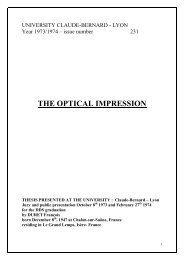english version(pg40to78) - Pr. François Duret
english version(pg40to78) - Pr. François Duret
english version(pg40to78) - Pr. François Duret
Create successful ePaper yourself
Turn your PDF publications into a flip-book with our unique Google optimized e-Paper software.
F <strong>Duret</strong> and Coll. <strong>Pr</strong>incipes de fonctionnement et applications techniques de l’empreinte optique dans l’exercice de cabinet<br />
(traduction Anglaise)<br />
Page 108<br />
The manufacturing give access to all materials while freeing us of<br />
extremely frustrating constraints of the fabrication of a volume by<br />
moulding or lost wax. The possession of a biomaterial with rigorously<br />
defined and constant performances will help the operator to better<br />
“reason” his action depending on the only requirements imposed by<br />
the clinical circumstances.<br />
CONCLUSION<br />
The realisation of a prosthesis mustn’t, today, anymore be considered<br />
an artistic action but a scientific realisation. It is necessary to delete<br />
from our vocabulary the term dental art which makes us certainly<br />
dreamy but opens the door to dangerous artistic “uncertainty”. The art<br />
zone seems to us more of a scientific no man’s land rather than a pure<br />
aesthetic creation zone.<br />
Despite the very high technology used for the fabrications, the<br />
prosthetic technique stays fundamentally arbitrary. Working with<br />
CAD/CAM enables us to have access to a multitude of interactions<br />
and manage the communications between the different realisation subsystems.<br />
As well as having a productive ensemble minimising the risks on<br />
traditional steps which we will keep, we are thinking of suppressing<br />
certain complex steps such as the use of articulators. Past the<br />
traditional production, we are given the choice of a multitude of new<br />
materials surpassing by far, by their mechanical and aesthetic<br />
qualities, the bodies which we know today.<br />
The hope which animates us mustn’t hide the extreme difficulty of<br />
realising such a set. However, even if for some we are in the dream<br />
zone, we all think we have opened a new way bringing high level<br />
techniques to our profession, that is to say electro optics, electronics,<br />
3D computer science and robotics. We also think that few methods<br />
today give us the same hope.<br />
The work presented by the teams such as B. TOUATI’s confirm our<br />
immense hope associated to materials as well as luting mode.<br />
Les Cahiers de <strong>Pr</strong>othèse (50) pp 73 – 110, 1985



